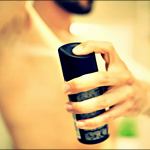A horsefly is a large fly belonging to the Tabanidae family of insects of the Diptera order. It is also known by other names like forest fly, deer fly, and March fly. It is regarded as the largest species in the true flies insect category.
A horsefly appears the same as a normal housefly, but is a lot bigger and darker. It measures about 2.5 cm.
A horsefly bite can be identified as formation of reddish bumps on skin along with itching and pain.
Facts about horseflies
- More than 3000 types of horseflies occur on planet Earth. The insect resides and breeds in marshy or wet areas that are located next to water bodies. Horseflies are usually active during warm and sunny climatic conditions.
- Female horseflies feature unique saw-blades-like jagged mouth parts which are used for sucking blood form human beings or animals. A horsefly bite can cause a lot of pain because it is marked by the creation of a hole from which blood oozes out. A lot of horseflies on a prey can suck about three ounces of blood on a daily basis.
- Male horseflies do not have such mouth parts. Their diet consists of nectar and pollen and thus play a part in pollination of varied plants.
- The mating location, time, and season for horseflies typically varies as per the species. A female horsefly will lay long, flattened, and dark eggs on plants or stones present near a water body. The larvae drop into moist or damp soil or mud or into water after the eggs hatch. They appear like maggots and do not have legs. The larvae body may look flat; however, the body is divided into segments and each segment has fleshy protrusions that aid the process of movement. Larvae eat snails or other insect larvae. After spending the winter months as larvae, they pupate in spring and turn into winged flies as early summer arrives. An adult horsefly usually lives for a few days.
- Female horseflies have to feed on blood for survival after they lay eggs. This is when they begin biting humans and animals. Female horseflies typically suck the blood off mammals. But they may also feed off birds, reptiles, and/or amphibians.
Symptoms of a horsefly bite
A horsefly bite refers to a skin cut made by the insect by the use of its mandible-like serrated scimitars. The top layer of skin gets peeled away and this process can cause a feeling of needles or pins pricking in skin. The insect then feeds on blood that oozes out of the wound created by the horsefly bite.
It is possible for a horsefly bite to cause more discomfort and pain than even a bee sting. Also, the healing process is longer as the skin gets sliced off.
Listed below are the signs and symptoms accompanying a horsefly bite:
- Immediate formation of red or pinkish bump on skin.
- Histamine is released to the area of the horsefly bite which can lead to itchiness and inflammation.
- Patients may experience weakness and/or dizziness
- The lips and eyes and areas around it may develop itchiness along with pinkish or red inflammation or swelling.
- Horsefly bite allergic reactions may result in wheezing, hives, breathing issues, and skin rashes, etc.
- Infection of the open wound may result in redness, oozing of pus, and extreme pain. Patients should medical attention for such infections.
Effects
- A female horsefly is a carrier of varied illnesses like rabbit fever, anthrax, and tularemia. Blood borne diseases and infections caused due to horsefly bite may fully cure only after many days.
- Animals may suffer from excessive blood loss, particularly if many horseflies are feeding on a particular prey. Animals with excessive blood loss may sometimes suffer from weakness or even die.
- Humans may sometimes suffer from deadly anaphylactic allergic reactions to horsefly bites.
- Humans as well as animals may experience anemia in case of blood loss due to horsefly bite.
Horsefly Bite – Pictures

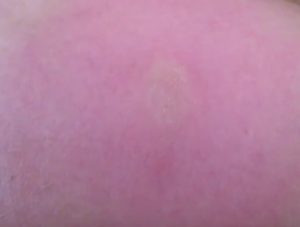
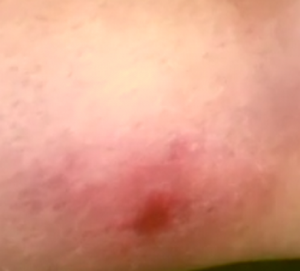
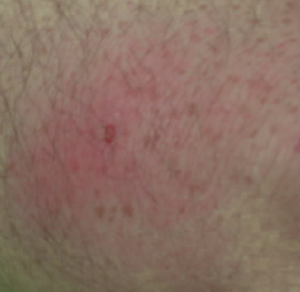
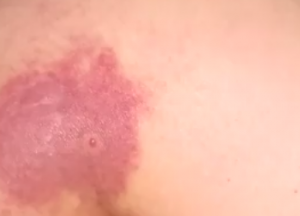
Treatment
Patients need to immediately visit a doctor in case of a horsefly bite, especially if they experience breathing problems or other severe allergic reactions.
A few home remedies for treatment of horsefly bite are as follows:
- Clean the wound with an antiseptic soap and warm water. Then pat dry the area.
- If easy access to soap and water is unavailable, then apply saliva on the affected spot to lessen swelling and inflammation. Histatin protein in human saliva has healing properties.
- Discomfort associated with horsefly bite can be eased with antihistamine tablets.
- Apply hydrocortisone cream to find relief from swelling and itching. Later cover the skin cut with a loose gauze bandage.
- Use of a cooling pad or application of ice cubes or aloe vera juice can also help alleviate pain and swelling
- Pain can also be eased with mud therapy or topical application of baking soda paste, Epsom salt, honey, and/or raw onion or garlic.
- Avoid scratching the horsefly bite to alleviate itching as it can further damage the skin and increase the risk to secondary infections.


